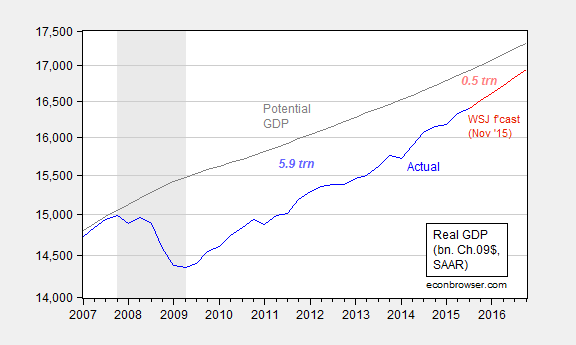…very slowly
According to CBO’s August 2015 estimate of potential GDP, the current output gap is 3.2% (log terms); using the WSJ November survey mean growth rates, even by the end of 2016, output will still be 2.2% below potential.

Figure 1: Real GDP (blue), Wall Street Journal mean forecast (red), potential GDP (gray), all in billion of Ch.2009$ SAAR. Figures are cumulative losses. NBER defined recession dates shaded gray. Left axis is a log scale. Source: BEA 2015Q3 advance, CBO, An Update to the Budget and Economic Outlook: 2015-2025 (August 2015), WSJ November survey, NBER, and author’s calculations.
Even using the highest forecasted growth rate (after 20% trimming), the gap is 1.6% (that forecast is from Ian Shepherdson of Pantheon Economics). Increasing the policy rate in December, which seems to be a done deal, is unlikely to mean a faster reversion to potential. The mean forecast implies an additional cumulative amount of lost output of 0.5 trillion Ch.2009$ in the five quarters between 2015Q4 and 2016Q4.
Of course, the CBO estimate is just an estimate. The OECD (November) estimate for 2015 is 2.0% of potential GDP, while the IMF’s (October) is 1.6%. Both estimates of the (absolute value of the) output gap are smaller than the CBO’s; on the other hand, using information from actually reported inflation suggests a much greater degree of slack than these production function approaches.
So how large would Obama’s stimulus bill had to have been to have closed the gap by 2010?
not sure if 2010 would have been the true target. do you believe the stimulus was too big, too small or just right?
The U-6 suggests it is -1%. Time for a benchmark upward revisions to 2009-14 GDP? The real stinker is, 10+ years later, they will and we will go “oh, I guess things were better than we thought”. I just think they overestimate inflation. The current model is broken and demands inflation. Thus, that is how these agencies build the “GDP” factory. When you go into no inflation, their models break down.
Menzie,
The note describing Figure 1 says that the left axis is in log scale. What am I missing?
You must be confused because it shows the actual gdp values rather than logs , but it’s clearly a log scale. I’d like to see this practice become the norm , since most people can’t relate as well to abstract log values as to the actual measure in question.
2slugbaits: The scale is logarithmic (note the tick marks are not equidistant), not the variable itself. I’ve taken to doing this because so many readers have difficulty with looking at logged variables.
Okay. I see that looking at a desktop monitor. Missed the tick marks when using a small tablet screen.
How much of the cumulative output gap is the result of monetary policy and how much is the result of Washington politicians?
And, how long can this expansion last, given it’s now the fourth longest in U.S. history?
Over the past few years, we’ve allowed terrorist factions to grow strong, while people against the terrorists are fleeing or being slaughtered.
Given successive terrorist attacks recently, an attack on the U.S. may be enough to tip the country into recession and the U.S. is in a very weak position now to deal with a recession.